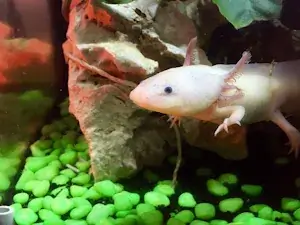Axolotl Care: A Comprehensive Guide
Axolotls, also known as “Mexican Walking Fish,” are fascinating amphibians gaining popularity due to their extraordinary regenerative abilities and exotic appearance. However, keeping axolotls requires specific knowledge to meet their needs and provide a suitable environment. This article covers everything you need to know about axolotl care, from setting up their tank to feeding, maintenance, and health tips.
1. What Are Axolotls?
Axolotls (Ambystoma mexicanum) are aquatic amphibians native to lakes in Mexico. They are renowned for:
- Regenerative abilities: Axolotls can regenerate limbs, organs, and even parts of their heart or brain.
- Larval state: They remain aquatic throughout their lives, retaining features like gill stalks.
- Calm temperament: Axolotls are peaceful and fascinating pets to observe.
2. Prerequisites for Keeping Axolotls
Caring for axolotls differs significantly from keeping typical aquarium fish.
Tank Size
- A single axolotl requires a tank at least 80 cm long (~100 liters).
- For multiple axolotls, aim for tanks 120 cm or larger.
Water Temperature
- Axolotls prefer cool water, ideally between 14–20°C (57–68°F).
- Temperatures above 22°C (72°F) can cause stress and increase the risk of illness.
Water Quality
- pH: Neutral to slightly alkaline (7.0–8.0).
- Nitrite/Nitrate: Keep levels close to zero; axolotls are sensitive to poor water quality.
- Filtration: A quiet yet effective filter ensures clean water. Avoid strong currents.
3. Setting Up the Axolotl Tank
The tank setup should mimic the axolotl’s natural habitat.
Substrate
- Sand: Fine sand is the safest choice since axolotls may accidentally ingest it.
- Avoid gravel: Large gravel can cause blockages if swallowed.
Hiding Spots
- Axolotls enjoy dark, sheltered areas. Provide caves, roots, or large plants.
- PVC pipes can serve as simple hiding places.
Lighting
- Axolotls prefer dim lighting. Use low-intensity lights or create shaded areas with plants.
Plants
- Use cold-water plants like Anubias or Java fern. Ensure they are securely anchored, as axolotls may dig them up.
Decorations
- Avoid sharp edges, as axolotls have delicate skin.
4. Feeding Axolotls
Axolotls are carnivores and require a protein-rich diet.
Suitable Food Options
- Live food: Earthworms, bloodworms, small shrimp.
- Frozen food: Beef heart, frozen bloodworms, or fish pieces.
- Pellets: Special axolotl pellets provide a balanced diet.
Feeding Frequency
- Juveniles: Feed daily.
- Adults: Feed 2–3 times a week.
Feeding Tips
- Remove uneaten food to maintain water quality.
- Use tweezers to offer food directly to the axolotl.
5. Tank Maintenance
A clean and well-maintained tank is crucial for the health of axolotls.
Water Changes
- Replace 20–30% of the water weekly to maintain quality.
- Use dechlorinated and temperature-matched water.
Filter Maintenance
- Clean the filter regularly but avoid cleaning all media at once to preserve beneficial bacteria.
Temperature Monitoring
- Check water temperature daily.
- In hot weather, use a cooling system or ice bottle method to lower the temperature.
6. Behavior and Socialization
Axolotls are solitary animals but can coexist peacefully if given enough space.
Behavioral Traits
- Axolotls are curious and love exploring their surroundings.
- They are crepuscular, meaning they’re most active during dawn and dusk.
Group Dynamics
- Only house axolotls of similar size together to prevent cannibalism.
- Avoid keeping them with fish, as fish may damage their delicate gills.
7. Health and Disease Prevention
Axolotls are delicate creatures, and proper care is essential to prevent illness.
Common Health Issues
- Fungal infections: Appear as white, cotton-like patches. Treat with salt baths.
- Bacterial infections: May cause appetite loss or skin changes.
- Heat stress: Symptoms include lethargy and skin problems caused by high temperatures.
Prevention Tips
- Maintain stable water quality.
- Provide a varied but moderate diet.
- Regularly observe axolotls for changes in behavior or appearance.
8. Legal Considerations
Axolotls are protected in the wild as they are endangered. Check local laws regarding axolotl ownership and trade.
9. Common Mistakes in Axolotl Care
Overheating
Temperatures above 22°C (72°F) can cause severe stress. Always monitor the tank temperature.
Incorrect Substrate
Gravel or coarse sand can lead to life-threatening blockages if ingested.
Inappropriate Tank Mates
Avoid keeping axolotls with fish or other animals that could harm them.
10. Conclusion: Exploring the Fascinating World of Axolotls
Caring for axolotls is a rewarding hobby, but it requires careful preparation and attention. These unique creatures thrive in a well-maintained tank, with proper feeding and attentive care. By creating a suitable environment, you can ensure your axolotls lead a healthy and happy life, while enjoying their extraordinary charm and behavior.anges und glückliches Leben ermöglichen.

